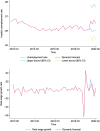Can wage changes solve the labour crisis in the National Health Service?
- PMID: 39652220
- PMCID: PMC12204917
- DOI: 10.1007/s10198-024-01737-4
Can wage changes solve the labour crisis in the National Health Service?
Abstract
This study aimed to examine the healthcare labour demand and supply elasticity regarding wage in the National Health Service (NHS) in England amid a labour crisis. A simultaneous error-correction regression analysis was conducted using secondary data from the NHS and Office for National Statistics from 2009 Q3 to 2022 Q1. Findings indicate both labour demand and supply of HCHS doctors in the NHS are highly inelastic with respect to real wages, with only a 0.1% decrease in NHS staff hiring and a 0.8% rise in NHS staff's willingness to work as full-time equivalents per 10% wage increase. Approximately 22% of the wage disequilibrium adjusts quarterly, indicating moderate speed of wage adjustment. Our results suggest that wage setting is not a sufficient solution to the labour crisis. Innovative and sustainable solutions are needed to reduce the demand for skilled health labour and increase the supply of health labour.
Keywords: Forecasting; Labour market; Macroeconometrical modelling; National Health Service (NHS).
© 2024. The Author(s).
Conflict of interest statement
Declarations. Conflict of interest: None.
Figures





Similar articles
-
Joy, sorrow and invisible work and theoretical inconveniences in the labour process of community nurses.J Health Organ Manag. 2025 Jun 25;39(5):729-743. doi: 10.1108/JHOM-09-2023-0274. J Health Organ Manag. 2025. PMID: 39810298
-
Factors that influence the provision of intrapartum and postnatal care by skilled birth attendants in low- and middle-income countries: a qualitative evidence synthesis.Cochrane Database Syst Rev. 2017 Nov 17;11(11):CD011558. doi: 10.1002/14651858.CD011558.pub2. Cochrane Database Syst Rev. 2017. PMID: 29148566 Free PMC article.
-
Lenvatinib plus pembrolizumab for untreated advanced renal cell carcinoma: a systematic review and cost-effectiveness analysis.Health Technol Assess. 2024 Aug;28(49):1-190. doi: 10.3310/TRRM4238. Health Technol Assess. 2024. PMID: 39252678 Free PMC article.
-
Staff perspectives of emergency department pathways for people attending in suicidal crisis: A qualitative study.J Psychiatr Ment Health Nurs. 2024 Jun;31(3):313-324. doi: 10.1111/jpm.12991. Epub 2023 Oct 20. J Psychiatr Ment Health Nurs. 2024. PMID: 37860987
-
Discontinuation of intravenous oxytocin in the active phase of induced labour.Cochrane Database Syst Rev. 2018 Aug 20;8(8):CD012274. doi: 10.1002/14651858.CD012274.pub2. Cochrane Database Syst Rev. 2018. PMID: 30125998 Free PMC article.
Cited by
-
Comparison of the EQ-5D-Y and the CHU-9D instruments in a general child population based on self-reports and proxy-reports.Eur J Health Econ. 2025 Jun;26(4):577-588. doi: 10.1007/s10198-024-01722-x. Epub 2024 Sep 28. Eur J Health Econ. 2025. PMID: 39340752
-
Health utility scores of six common cancers in China measured by SF-6Dv2.Health Qual Life Outcomes. 2025 Jan 12;23(1):5. doi: 10.1186/s12955-025-02332-8. Health Qual Life Outcomes. 2025. PMID: 39799326 Free PMC article.
-
Comparison of the measurement properties of EQ-5D-5L and SF-6Dv2 in Chinese patients on dialysis.Health Qual Life Outcomes. 2025 Jul 10;23(1):71. doi: 10.1186/s12955-025-02403-w. Health Qual Life Outcomes. 2025. PMID: 40640853 Free PMC article.
References
MeSH terms
Grants and funding
LinkOut - more resources
Full Text Sources

